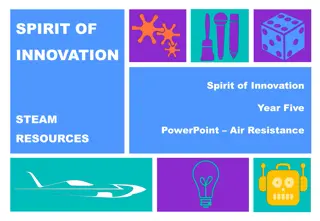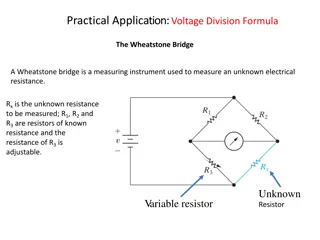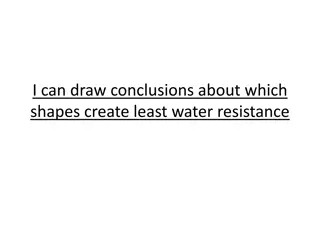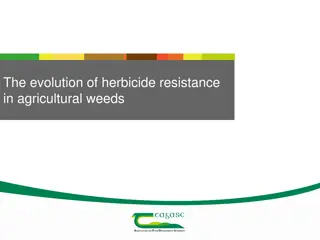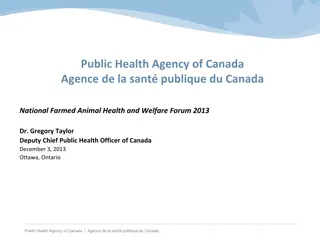Understanding Water Resistance in Everyday Life
Water resistance is a type of friction experienced when objects move through water, similar to air resistance. This force slows down objects moving through water, like when swimming. Animals and humans adapt by using streamlined designs to reduce water resistance. Experimenting with different shaped objects in water can demonstrate the effects of water resistance.
Download Presentation

Please find below an Image/Link to download the presentation.
The content on the website is provided AS IS for your information and personal use only. It may not be sold, licensed, or shared on other websites without obtaining consent from the author. Download presentation by click this link. If you encounter any issues during the download, it is possible that the publisher has removed the file from their server.
E N D
Presentation Transcript
WALT understand water resistance.
Water resistance is a type of friction just like air resistance. Friction occurs when objects move through water or air. Air resistance is a type of friction between air and another material. ... If you go swimming, there is friction between your skin and the water particles. This is known as water resistance. The water slows down an object that is moving through it. Have a look at the bitesize information about air and water resistance. https://www.bbc.co.uk/bitesize/topics/zsxxs bk/articles/zxw6gdm
Water Resistance water resistance If you have ever walked through water, you will have felt the effects of water resistance pushing against you. swimmer s force Whenever an object moves through water, it experiences the force of water resistance. Water resistance pushes objects back, making it hard for them to move through water.
Many animals and natural things have adapted to make it easier to move through water and so lessen the amount of friction (water resistance). Humans do this too, when they design and build things that they want to move through water easily. This design is called: Streamlined
Streamlined Shapes This aeroplane is streamlined. Its nose is pointed so it can cut through the air, and it has a low, smooth, curved back to allow air to flow over and around it. It does not create much air resistance so it can move through the air easily.
Streamlined Shapes The shark is streamlined. It has a pointed nose to cut through the water, and a smooth, low, curved back to allow the water to flow over and around it. It does not create much water resistance so it can move through the water quickly.
The next two slides will take you through the experiment. You dont have to do it in exactly the same way. If you haven t got tin foil but you have got plasticine or play dough then you can make shapes out of that. You may have something else you can use. Your task is to experiment with different shaped objects to see how quickly they fall through water. Large plastic soft drink bottles make good containers to drop the objects through, as they are tall. Alternatively, you could find different objects that are similar in weight and size, but shaped differently and have different amounts of surface area. Compare how long they take to sink.
Here someone has gathered together 3 containers of water. You can use 1 container and time how long the objects take to sink. 3 pieces of the same size tin foil. Why do they have to be the same size?
You will experiment with different shaped pieces. Use the same amount of tin foil as it will be a fair test. You could make a pointy shape, and round shape etc. You will drop them through the same amount of water and record which fall the quickest etc. Open the word document Water resistance experiment and start recording and make your predictions. Drop them from the same height and see which fall the fastest. Record your results and write your conclusion. Take some photos if you can.
This clip shows a similar experiment being carried out. If you cant complete the experiment yourself, then you can watch it being done here. https://www.bbc.co.uk/teach/class-clips- video/science-design-and-technology-ks2- investigating-air-and-water- resistance/z4m6nrd
Density How much matter is inside an object Now for the important science facts. Use this information to help you write your conclusion. You can use diagrams too to explain what you have found out. More dense = more stuff packed inside Less dense = less stuff packed inside. Two forces are at play in this experiment. Gravity is pulling things down in the water, while buoyancy pushes upward against gravity. Different objects behave differently in the water depending on their density and their surface area(think about the parachutes) A crumpled ball of foil has more density because all of its weight concentrates in a small space. Our foil boat is spread out, less dense and therefore can float the objects that would normally sink on their own (i.e. stones). If the surface area is increased there is more water pushing against it and slowing it down. If you reduce the surface area then there is less surface for the water to push against and the object moves through the water more easily so will travel faster. I would love to see your science work, even if it is just a photo of you experimenting. It is the thinking and the talking about what you are doing that is important.







